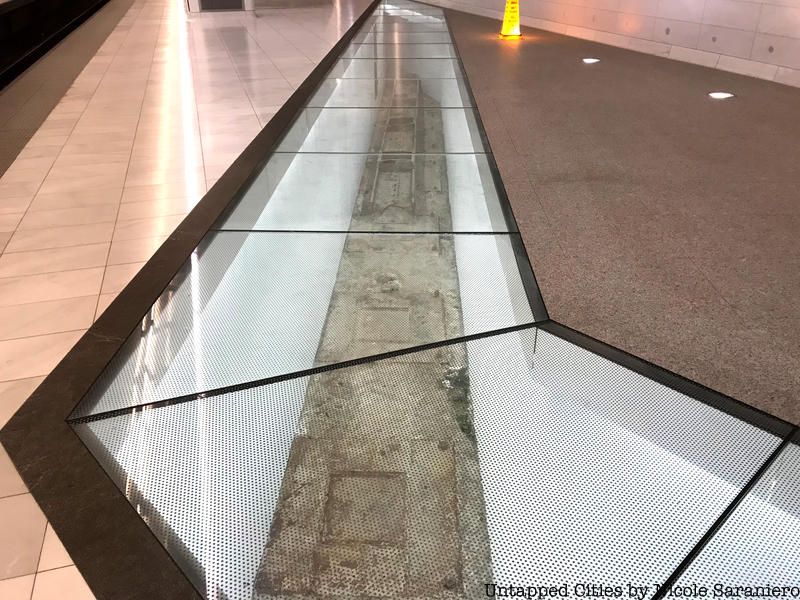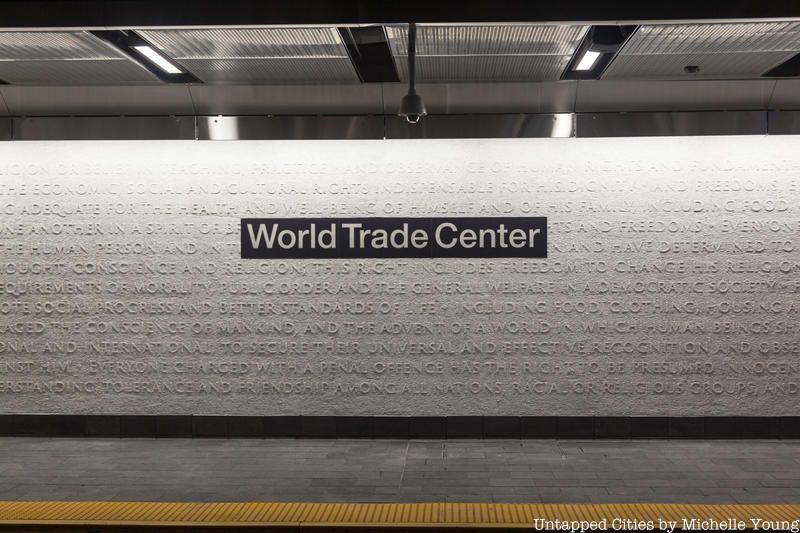See Wildlife and Abandoned Islands on an NYC River Cruise
Sail past a seal hangout and keep your eyes peeled for migrating birds as you sail past historic bridges, abandoned islands, and iconic NYC sites!



Two decades ago, when the Twin Towers were attacked on September 11, 2001, Lower Manhattan would be forever altered. Not only did an iconic piece of the skyline disappear, taking with it almost 3,000 lives, the demolition, rebuilding, and reshaping of the site has been in progress for seventeen years. Along the way, new buildings opened – 1 WTC, 3 WTC, 4 WTC, the Santiago Calatrava-designed transportation hub (aka the Oculus), and others. The 9/11 Memorial & Museum opened, and new streets were run through the former super block, along the same paths they once took before the Twin Towers were built. A new elevated park was built and the Cortlandt Street subway station re-opened just this past Saturday. A new performing arts center is on the way and after financial troubles, the new St. Nicholas Orthodox Church is back on track.
Despite the steady, yet drawn-out construction that has made the World Trade Center what it is today, there are many remnants that can be located on the same 16-acre site. It’s the 20th anniversary of the 9/11 attacks on the World Trade Center but if public commemoration is less your thing, use this guide to spend today or any day to note the reminders of what once was here.

These two 70-foot tridents from the South Tower that were once enveloped in aluminum. After the World Trade Center attacks, they were catalogued and stored with other artifacts in the hangar at JFK Airport, and then brought back to the site to be placed in the entrance pavilion of the 9/11 Museum. By September 2013, the tridents were already in the space, although the museum did not open until May 2014. According to the 9/11 Memorial & Museum, each trident weights 52 tons.

After E and C train straphangers pass through the turnstiles of the World Trade Center subway stop — before they enter into the modern arches of the Oculus — they first walk through the last remains of the original World Trade Center subway concourse and past a door tagged by 9/11 first responders, probably without even noticing.
Heading through the metallic doors into the entranceway of the station, commuters walk over the same travertine floors, under the same signs and up the same ramp as commuters who entered the WTC complex before the terrorists attacks of September 11, 2001. This entranceway is comprised of the last surviving pieces of the original 1970s WTC subway concourse.
The most poignant reminder of the former World Trade Center and the tragic events of 9/11 is a door, which was deliberately retained, that stands out from the rest due to its bright orange, graffiti-like markings. A sign on the door’s encasement decodes the marks, which were made by search and rescue teams in the immediate aftermath of the 9/11 attacks. On the door, first responders used spray paint to indicate the date the area was searched (9/13/01), the condition of the area (X, meaning dangerous) and which agency performed the evaluation, in this case the Massachusetts Task Force 1 of FEMA (MATF 1).

The engineering firm Skanksa built both the original World Trade Center and the new Transportation Hub (aka Oculus), designed by Santiago Calatrava. In the Oculus, which services the PATH train, the 1 subway line (with walkways to the Fulton Street subway lines), there was a deliberate move to remember what happened on 9/11.
To that end, the design has made visible the sections of the original steel framework and concrete foundation of the Twin Towers. You can see these sections under glass on the platform of the PATH station.

The original slurry wall of the World Trade Center enclosed an enormous basement the size of four city blocks by two city blocks, known as the “bathtub,” that held back the water from the Hudson River. Half of the World Trade Center site exists on landfill over what was originally marshland and water. The basement itself took up 70% of the World Trade Center site, and was surrounded by a 3,500 foot long slurry wall that was three feet thick.
According to George J. Tamaro, one of the engineers who was in charge of the construction of the slurry wall, the wall survived the 9/11 attacks “mostly intact.” In the design of the 9/11 Memorial & Museum, part of the slurry wall became the focal point of Foundation Hall, a 40 to 60 foot high space that also contains the “Last Column,” a 36 foot tall piece of steel signed by first responders, recovery workers and volunteers. The creation of the bathtub of the original World Trade Center resulted in the excavation of 1 million cubic yards of soil and other material, which eventually formed the foundation of Battery Park City, yet another one of the many man-made places in New York City built atop excavation from somewhere else.

The pedestrian bridge over West Street along Liberty Street, which today looks like an incongruous boxy structure, is another survivor from 9/11. Though damaged, it was repaired and reopened in 2002, with additional work done in recent years. Its counterpart, a pedestrian bridge on Vesey Street, was destroyed in the attacks due to the collapse of the Twin Towers. Historic photographs show the Liberty Street Bridge standing amidst the rubble, with steel beams twisted in all directions.
For more than a decade, there were marks remaining on the exterior of the bridge, believed to have been sustained when the South Tower fell. The aluminum panels of the Liberty Street bridge were replaced in the most recent restoration, and the bridge can now be accessed from Liberty Park, which opened in 2016, and from Brookfield Place.

Created by German sculptor Fritz Koenig, the recognizable metallic sphere, symbolizing peace, hope and resiliency, formerly served as a centerpiece in the Austin J. Tobin Plaza between the Twin Towers, where it stood for three decades prior to the 9/11 terrorist attacks.
Starting in March 2002, the sculpture was on display in The Battery, where it was temporarily placed after it was recovered from the debris following the attacks. In September 2017, the sphere returned to the World Trade Center site in Liberty Park.

The iconic “Ground Zero Cross,” a group of steel beams in the shape of a cross from the rubble of the World Trade Center, was quite possibly the very first shrine after the attacks. From around the time it was found at Ground Zero, those with access used the cross as a place to leave flowers, notes, and pictures of loved ones.
As the site was being cleared, the cross was moved to St. Peter’s Roman Catholic Church at the intersection of Barclays and Church streets just a block away from Ground Zero. When the 9/11 Memorial & Museum opened, it was relocated as part of the museum’s exhibits and a new cross was installed at St. Peter’s.

Within the 9/11 Memorial Plaza stands the Survivor Tree. It is a Callery pear tree that survived the attacks on 9/11, and was worked into the design of the Memorial Plaza. Damaged down to the stumps, workers managed to free it, and it was nursed back to health in a Bronx park by the New York City Department of Parks and Recreation, before it was replanted it again in Memorial Plaza in 2010.
The Survivor Tree is more than four times its original height back in 2001, easily towering over the other trees planted in the Plaza. Visitors flock around the tree–a living and breathing reminder that in tragedy there can also be rebirth, though the scars on the limbs bear testament to the events on 9/11.

On September 8th, 2018 the Cortlandt Street subway station at World Trade Center servicing the 1 line re-opened to riders for the first time since it was severely damaged during 9/11 under the weight of the debris from the Twin Towers collapse. For nearly two decades, it sat as a ghost station, viewable as the train passed by. The station, which is officially renamed WTC Cortlandt, features wall-to-wall marble mosaic artwork by artist Ann Hamilton, showing text from the 1776 Declaration of Independence and 1948 United Nations Declaration of Human Rights.
The station shell is the same as the original Cortlandt Street station, though significant work had to be done to repair it, along with the tracks and tunnel. The new station also has fewer columns than before, allowing for easier customer flow.

There were over 5,200 entries in the World Trade Center Memorial Design Competition in 2003. The winning design, “Reflecting Absence,” came from architects Michael Arad and Peter Walker, and retained the exact footprints of the original Twin Towers. Each reflecting pool is about an acre in size, with 30 feet granite walls over which 26,000 gallons of water flow a minute. Taken together, the two pools constitute the largest man-made waterfall in North America.
According to the Memorial Jury that chose the winner, the design “fulfills most eloquently the daunting but absolutely necessary demands of this memorial. In its powerful, yet simple articulation of the footprints of the Twin Towers, ‘Reflecting Absence’ has made the voids left by the destruction the primary symbols of our loss.
“By allowing absence to speak for itself, the designers have made the power of these empty footprints the memorial. At its core, this memorial is anchored deeply in the actual events it commemorates-connecting us to the towers’ destruction, and more important, to all the lives lost on that day….”
Next, check out and 14 World Trade Center Remnants All Around NYC and NYC’s supertall skyscrapers, including 1 WTC.
Subscribe to our newsletter